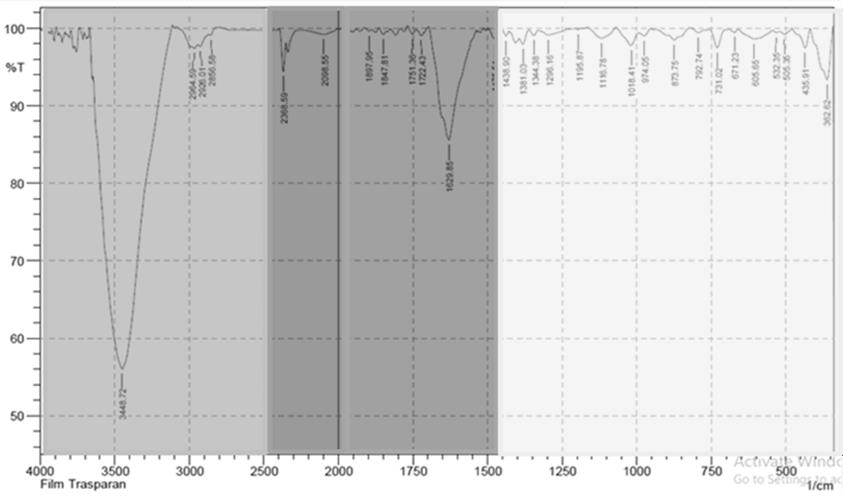STUDY OF IDENTIFICATION OF MICROPLASTIC WASTE IN SEDIMENTS SAND AT LAMBUTOA BEACH, TAKALAR DISTRICT
DOI:
https://doi.org/10.62012/sensistek.v5i2.24753Keywords:
Kata Kunci: Sampah, Mikroplastik, FTIR (Fourier-Transform Infrared Spectroscopy), PolimerAbstract
Indonesia is currently one of the countries in East Asia which produces around 50% of waste coast in the world. Microplastics in Indonesian seawater range from 30 to 960 particles/liter. The purpose of this study was to determine the size, amount, type, and existing microplastic polymers on Lambutoa Beach in Takalar District. This study uses quantitative methods to examinein a particular population or sample. The research method used is a quantitative research method.Quantitative research methods study a particular population or sample, collecting data with use research tools, and analyze quantitative or statistical data for the purpose of testing and prove the hypothesis that has been formulated/set to be used. As for the steps taken during the research process, namely sand sediment sampling, sediment sample processing sand, observing and identifying types of microplastics, and testing using the FTIR tool. From the results In this study, there were 49 samples of microplastic waste with an average size of 1-5 mm. The microplastics contained in the sand sediments that have been tested have three types, namely film, fragments, and foam. For the most common type of polymer found in sediment sample testing using the FTIR tool on microplastic samples is a type of polymer Other (Nylon) and PET (Polyethylene terephthalate).Downloads
References
Angelica, P. G. (2022). Identifikasi Sampah Laut (Marine Debris) pada Kawasan Pantai di Pulau
Kodingareng Lompo Kota Makassar (Doctoral dissertation, Universitas Hasanuddin).
Djongihi, A., Adjam, S., & Salam, R. (2022). Dampak Pembuangan Sampah di Pesisir Pantai TerhadapLingkungan Sekitar (Studi Kasus Masyarakat Payahe Kecamatan Oba Kota Tidore Kepulauan). JurnalGeocivic.
F. Budiman, Y. Setyawan, dan A. Ando Yosafat, “Menganalisis Karakteristik Sedimen Dan Morfologi Muara Sungai Kapuas Guna Memperlancar Alur Pelayaran”, zonalaut, vol. 1, no. 3, hlm. 124-132, Nov 2020.
Amiruddin, Amiruddin, and Habibi Palippui. "Analisa Penanggulangan Sampah Plastik Dipesisir Wilayah Pantai Ujung Suso Dengan Menggunakan Media Buangan Limbah Kawah Galian Tambang Nikel Soroako." Riset Sains dan Teknologi Kelautan (2020): 77-81.
Fadilah, S. S. (2021). Analisis Faktor Hidro-Oseanografi Terhadap Kerusakan Pantai KecamatanPondok Kelapa Kabupaten Bengkulu Tengah dan Penentuan Konsep Penanganannya. Jakad Media Publishing.
Y. Yusman, “Pengaruh Arus Laut terhadap Sedimentasi di Pantai Barane Kabupaten Majene”, zonalaut, vol. 1, no. 1, hlm. 21-25, Mar 2020.
Hartman, A., & Lovén, E. (2014). Plastic as marine debris and its potential for economic value: A practical and analytical estimation of the marine debris characteristics and a comparative evaluation ofpossible treatment procedures.
Ikhsan, M., Al-butary, B., & Wulandari, S. (2022). Pelatihan Membangun Jiwa Wirausaha DalamMengolah Limbah Plastik Menjadi Tas Bagi Ibu-Ibu Desa Tanjung Siporkis Di Kecamatan GalangKabupaten Deli Serdang.
Mahadika, R. S. (2022). Identifikasi Mikroplastik Di Perairan Dan Pesisir Laut Kabupaten Purworejo.
Norhijah, R., Nurmalasyiah, N., & Suriyani, E. (2018). Pengelolaan Sampah Rumah TanggaBerdasarkan (Pemilihan, Pengumpulan, dan pengangkutan dari TPS ke TPA PERBUP No 89 Tahun2017) di Desa Baruh Panyambaran Kecematan Halong Kabupaten Balangan. JAPB, 1(2).
Rahmadhani, F. (2019). Identifikasi dan analisis kandungan mikroplastik pada ikan pelagis dandemersal serta sedimen dan air laut di perairan Pulau Mandangin Kabupaten Sampang (Doctoraldissertation, UIN Sunan Ampel Surabaya).
Saputro, Y. E., Kismartini, K., & Syafrudin, S. (2016). Pengelolaan sampah berbasis masyarakatmelalui bank sampah. Indonesian Journal of Conservation.
Setyadi, F. (2018). Pantai Sulawesi Paling Tercemar Sampah Plastik. Valid News.
Sugito, N. T., & Sugandi, D. (2016). Urgensi Penentuan Dan Penegakan Hukum Kawasan SempadanPantai. Jurnal Geografi Gea.
United Nations Conference on Standardization of Geographical Names (UNCSGN) dan UnitedNations Group of Expert on Geographical Names (UNGEGN). (2017). Jumlah Pulau di Indonesia.Amerika Serikat, DPR-RI.
Wahyu, E. (2019). TA : Pencemaran laut. Universitas Muhammadiyah Makassar.
Winnerdy, F. R., & Laoda, M. (2020). Daur Ulang Plastik untuk Bahan Bangunan. Jurnal Strategi Desain & Inovasi Sosial.













